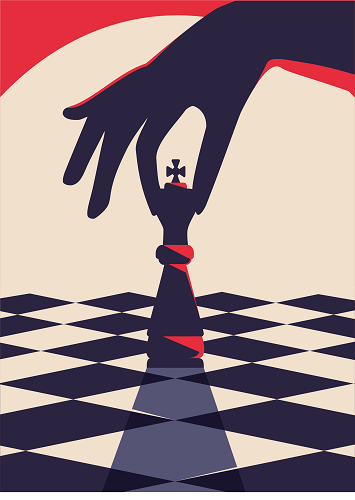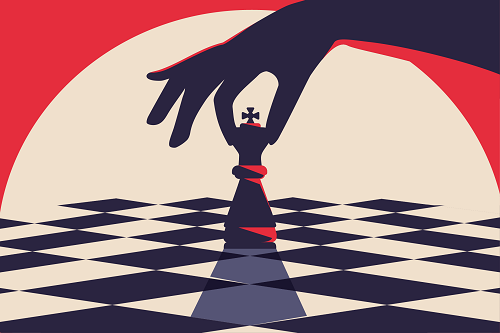 If you have watched the recent blockbuster series from Netflix, “The Queen’s Gambit,” you can understand why chess is showing such a resurgence in popularity. In fact, there are many books about how life imitates chess. What I’ve seen in my experience here at Balanced Scorecard Institute (BSI) is how it also imitates business, especially in the arena of performance management strategy execution.
If you have watched the recent blockbuster series from Netflix, “The Queen’s Gambit,” you can understand why chess is showing such a resurgence in popularity. In fact, there are many books about how life imitates chess. What I’ve seen in my experience here at Balanced Scorecard Institute (BSI) is how it also imitates business, especially in the arena of performance management strategy execution.
I vividly recall my first three games of chess played more than 50 years ago. If that seems oddly specific, it’s because my opponent, a year younger than I, beat me mercilessly in less than six moves each time. The experience was humbling but those defeats turned me into someone who could hold his own and become a formidable chess player over the next half-century. It also gave me a great appreciation for the importance of strategy when it comes to performance and winning.
Chess is a game that is loved by many all over the world. It presents an intense intellectual challenge that has many benefits, not only for your mind, but for your business. Let’s take a brief look at the game, its challenges, and the lessons it can provide for organizations in today’s rapidly changing world.
1. Assess the Entire Landscape
When someone is skilled in chess, they learn to anticipate their opponent’s next move — often several moves in advance. To accomplish this, a player must be able to know their opponent, understand their perspective, and come to a logical conclusion of what action they will likely take from among many possible scenarios. They must not only quickly recognize their opponent’s strengths and weaknesses, but also their own, then determine opportunities as well as assess any potential threats that could derail those plans. In other words, it is a continuous SWOT (strengths, weaknesses, opportunities, threats) analysis.
Sound familiar? It should. Successful strategy takes into account these SWOT elements and examines them from a micro and macro viewpoint. It is important to know what your organization’s capabilities are, but it is equally important to understand the external influences over which your organization has little or no control over and their potential to disrupt your organization’s strategy.
Many organizations today focus on the development of a strategic plan just to say they have one. Often, insufficient effort goes into this process. And if a thorough SWOT analysis (both internal and external) is not part of the process, you end up with a nice document that brings little or no value to the organization.
To be successful, organizations must learn to respond to the current environment—that is, respond to what’s happening on the “chess board of business” and just like a chess match, be willing to abandon any pre-conceived plan and have the ability to respond decisively to gain the advantage over the competition. In other words, a chess player must play what’s happening on an unpredictable board and not rigidly adhere to a strategy. A good strategy does not lock you into a specific course of action but provides you with agility and the ability to make adjustments to quickly respond to changes in the environment.
You may be able to execute on a strategy but doing so without considering the ever-changing bigger picture will almost always yield results far below expectations or targets.
2. Improve Performance
Winning at chess requires taking the necessary time to truly analyze and understand your environment. But chess is also about staying laser focused on what you are trying to achieve. Your business environment is no different. While it is important to be agile in a hyper connected marketplace, you must still know where you are going and the results you intend to deliver. This clarity combined with a holistic awareness of the environment gives you improved decision-making capabilities and puts your organization in a better position to handle challenges as they come. You are more aware of what disruptions are likely to occur and have developed different scenarios that allow you to adjust course based on the circumstances you find yourself in.
In chess, each piece has a specific value; each has strengths that if leveraged properly can change the outcome of the game. Likewise, it is essential that an organization’s leadership team understands the value of its employees, customers, and stakeholders. This type of knowledge is invaluable in decision making regarding job roles and responsibilities, accountability, marketing, sales, customer satisfaction and much more. Here are some tips to help you assess the value of your stakeholders, including employees.
- Assess your strengths and weaknesses. Knowing the strengths and values of those individuals in your organization’s ecosystem helps you to better manage your resources. Not only do you have to manage your resources (human and otherwise), but you must always keep your eye on the clock. Your organization may be larger than your competition, have more capital and more resources, but if it isn’t as responsive as your competitor’s and is unable to get things done quickly, you have already lost any advantage you may have had. At the same time, you need to ensure you balance your actions with patience. Before you can be effective as an organization against the competition, take the necessary time assess the landscape and make sure you have the knowledge, skills, abilities and resources in place to be successful. In other words, don’t rush something just to get it out there. Take the time to do it right, but don’t waste time with a lot of talk and no action. Being responsive is a delicate balancing act between speed and deliberation.
- Understand your worth as an organization. It’s always a good idea to fully understand the value your competition provides to its employees, customers and stakeholders because it helps you understand your unique differentiation. What is the value-add your organization offers that your competition doesn’t? If you can’t answer this, you are already behind in the game. Chess is both offensive and If you spend more time on the defensive side, you will probably lose unless you just happen to get lucky. The same principle applies to your organization. Be proactive while also taking the offensive. Be bold, be innovative, and be willing to sacrifice. Sometimes, you have to let something go in order to put yourself in a position that will give you the winning advantage. This is true in chess, in business and in life! Sometimes those pet projects or initiatives have to go by the wayside if you are ever going to make progress as an organization.
- Accountability matters. Be accountable and expect other to be accountable as well. This does not mean “kill the messenger.” Rather it means if something didn’t go as planned, figure out what happened, what went wrong, and why. Take those lessons and apply them to future endeavors to ensure success. By the same token, if something exceeds expectations, figure out why and replicate it. Never be complacent about either success or failure because both have much to teach your organization.
In other words, improving performance has a direct relationship and impact on improving strategy execution. If an organization is getting better and smarter at what it does, the odds for improvement in the area of strategy execution increase considerably.
3. Elevate Creativity & Innovation
Researchers at a school in India conducted a one-year study of the impact of chess training on a group of 31 children in the experimental group and 32 children in the control group. None of the children in this study had any previous knowledge of chess. The results of this study showed chess stimulated cognitive processes and strengthen intellectual ability and cognitive skills.
As part of this study, the participants were challenged to play competitively, analyze their own games, their strengths, and where they had made mistakes. Avni (1998) stated chess was an intelligent process involving four different steps: synthesis, gathering, enlightenment and realization. As a child progresses through these steps, he or she thinks beyond the usual solutions using divergent thinking, thinking abstractly, weighing options, evaluating outcomes and making decisions.
A key point to pull out of this study as it applies to organizations is that the children were taught chess systematically but were not coached or told how to play or what to do during the various matches. The study put students in a position to come up with alternative options for common items and to interpret patterns and meaning in the abstract on their own. The students were not micro-managed nor given constraints. Each child was presented with the opportunity to improvise and improve, commensurate with their skills, personality, and experience.
Often in work scenarios, organizations tend to fence workers in. They establish boundaries to set expectations and accountability and often fail to provide the individual with the opportunity to excel beyond these pre-set limitations. Sometimes it is the culture itself, which stifles the creative environment of an organization. I once worked in an industry where workers who exceeded productivity or were offering innovative process improvements were shunned by other workers and socially isolated in the work environment. Management tended to turn a blind eye to the culture and as a result, most simply gave up and conformed, negatively impacting individual performance and overall innovation.
If you are aiming for a high-performance organization, encouraging employee creativity and rewarding innovation should be near the top of your list of things to accomplish. When people get creative, the energy around them becomes contagious and others begin to think outside the normal boundaries of the work environment. Instead of asking “Why?”, the question becomes “Why Not?”
4. Enhance Planning Skills
When observing chess games, it is not uncommon to note long periods of silence during which players are contemplating the location of each piece on the board, potential moves, and the probable consequences. They are weighing options and determining what they believe their opponent’s response will be for every move open to them.
Playing chess requires problem-solving capacities in order to search through the present and possible future chess problem space, requiring the ability to calculate several moves ahead. A study conducted in the Tower of London in 2006 showed that chess players showed better planning performance than non-chess players, excelling in those areas of more difficult problems.
Planning skills have a direct impact on the ability of an organization to execute their strategic objectives and reach performance goals. It is essential that individuals with the right mindset, training, and experience be selected for this role in an organization. Individuals in these roles need to have the ability to conduct various scenarios, analyze the competition, and past successes as well as failures. They need to know what tools are out there to assist them in developing a viable, adaptable strategy that will put the organization in the best position to achieve the desired level of organizational success.
Be selective when looking for new talent to help with strategy execution. Hire the right people, then put them in the right place in your organization and make sure you have given them the tools to succeed. Don’t settle for second best. Hire people who are motivated, innovative and not afraid to take on challenges. Then stand back, give them the space they need and watch your organization grow and be great at execution.
There are a lot of theories about strategy execution, but there is no “one-size-fits-all” method that guarantees organizational success. This blog explores the importance of building your organizational culture to strengthen its creativity, innovation, learning, accountability, and productivity along with the right people—all to become a high-performance business. It is important to ask: Is your culture conducive to allowing your organization to be able to fully execute its strategy? If you want to learn more about how to assess and how to improve your performance management strategy, let’s talk. For assistance with your Strategy Execution, we can help. Contact us at info@strategymanage.com
Sources
Psychology, Computer Science / Cognitive Science 2017 A Study on the Impact of Chess Training on Creativity of Indian School Children, David Chandran. https://www.semanticscholar.org/paper/A-Study-on-the-Impact-of-Chess-Training-on-of-Joseph-Manoharan/4b13f637908b48e654044b4beec0fd336abbb6fb
Planning Abilities and Chess: a Comparison of Chess and Non-Chess Players on the Tower of London Task. https://pubmed.ncbi.nlm.nih.gov/168489
Terry is Balanced Scorecard Institute's Director of Training and Senior Associate with over 30 years of experience working in both the private and public sectors.


